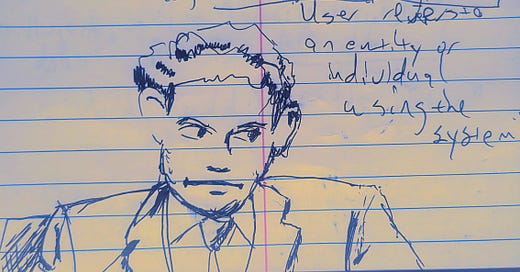The Boy Who Wasn’t There: Why Sam Bankman-Fried Matters
The fraudster of our generation also embodies some of our society's biggest failings.
I’m feeling mostly physically and mentally recovered from the marathon of covering the Sam Bankman-Fried trial. Last night I dropped by Pubkey to hear the CoinDesk trial team reminisce about getting up at 1am to get in line for the courtroom, and it already felt nostalgic less than a week later.
But the SBF trial was more than a courtroom spectacle chronicling the downfall of one severely misguided man. As I’ve argued before, in some sense, Sam Bankman-Fried was the creation of the many people and forces around him: the Stanford professors who raised him, the venture capitalists who backed him, the Oxford philosophers who guided him, and the media who mythologized him.
This, in a nutshell, is the core of the book about Bankman-Fried I’m now beginning work on. I’m in tentative discussions with a very exciting publisher, but whether or not that works out, the book will happen. You’re supporting its creation by subscribing to Flesh/Markets at any level, and there will be other (I think fairly exciting) news about how you can help soon.
The book will chronicle SBF’s downfall as the downfall of a much wider system of power, thought, and control. The story reveals the glaring failure of the ideas and worldviews that made him – largely ideas that gain their currency from being “contrarian” but that may just be deeply wrong. Sam Bankman-Fried had a role to play, one for which he was uniquely well-suited as a math geek with sociopathic tendencies. But FTX would never have happened if the people around him hadn’t found that useful in various ways, and elevated him to positions where he was most useful to them.
This is just one sense in which I interpret Bankman-Fried as “The Boy Who Wasn’t There”: he was an avatar for many other people, meant to represent the best of their ideas. This doesn’t mean he isn’t responsible for what he did. It means that what he did is a skeleton key that unlocks the deep realities of our time.
Sam Bankman-Fried: A Vessel for Dreams
One thing that became clear during the trial is that after everyone around him had filled Sam Bankman-Fried with their own goals and agendas, there was little room left for him to be a person of his own. It was frankly sad how focused he was, at every moment, on how he was perceived, rather than on anything he actually believed, or even on anything he wanted.
Perhaps the most damaging identity that was constantly cast onto Sam, of course, was that he was still a boy, even in his late twenties. It seems this began with his parents, in a contradictory sense: they explicitly treated him like “an adult” from a young age, at least as far as conversing about philosophy and the world went. But their actual rearing of him seems to have left him fragile and dependent in many ways, as we see hints of in their later relationship.
Bankman-Fried’s boyishness wasn’t truly weaponized, though, until he became an object of interest in Silicon Valley and the tech and business media. For investors, youth equals infinite potential – the younger, the better. The narrative of youth is particularly useful for venture capital, because it sends the message to LPs that a fund is getting in on the ground floor of something that could be very big. Same goes for Michael Lewis, whose deeply flawed book Going Infinite frequently depicts Sam as a kind of lovably roguish teenager – but with the added twist that what makes his childish behavior acceptable is that it’s secretly a sign of his eccentric brilliance.
Sam’s boyishness, then, is an aspect of the financialization of his life. That is, his present value to people like Lewis, no less than to investors at Paradigm, was premised on the idea of some future in which he became even more, even greater. It was literally profitable to frame his video gaming and other habits as merely a signal that this kid is going to make us so much money.
This is what makes Sam Bankman-Fried such an avatar for our time: He was a gambler who believed he could predict the future with mathematical precision. Others bet on his certainty, believing his gift of prophecy could deliver riches in the present.
They had reasons, going back decades, to think they might be right. Silicon Valley had promised the future, and in the form of companies like Microsoft and Google, they had seemingly delivered it, turning small initial pools of money into immensely profitable, if not exactly socially helpful, businesses.

But somewhere along the way, venture capital learned the wrong lessons from its past successes. This can be laid squarely at the feet of a figure who Sam Bankman-Fried would certainly claim to hate, if he even knew who he was: Peter Thiel. It was Thiel more than anyone who formalized a strategy known as “blitzscaling.” This amounted to giving so much money to a company entering a new category that it could build a dominant monopoly before anyone else could even get off the starting block.
This strategy has, at least in terms of headlines, led to an immense destruction of investor value across the world. That includes not just famously ill-conceived implosions like WeWork and Juicero, but to dozens of “zombie companies” like Uber and Instacart, whose profits have proven elusive, in some cases for more than a decade.
Of course, the venture capitalists themselves did quite well on deals like Uber, because what they sold to retail investors was a narrative about what would happen in the future. Sam Bankman-Fried, too, sold a story, consciously crafting the underdressed, undergroomed, Corolla-driving image of a self-sacrificing nerd genius.
Selling these stories about the future into the present has become more profitable than actually producing goods that make human life better today. And our obsession makes us easy victims: It was through tales of the technological future that Sam Bankman-Fried hacked his way past our society’s normal defense against fraudsters. The same could be said of Elizabeth Holmes, Do Kwon, Nikola’s Trevor Milton – even, in an only slightly hedged way, of Elon Musk.
It’s in this sense that Sam Bankman-Fried matters most: not as an individual, but as the latest model of a type that has come to plague us. It’s hard to definitively argue that they are becoming more common, but the amounts of money involved are certainly becoming larger – Bankman-Fried raised a truly absurd $1 billion dollars in venture capital, which he put to the purposes of stealing another $8 billion.
Bankman-Fried is, however, the youngest of the crop, just on the cusp between Millenial and Zoomer. While his individual neurology is not for me to speculate too much on, he certainly seems to represent the loneliness that young people have suffered, and he certainly doesn’t seem to have benefitted from spending his entire life staring at computer screens.
John Ray, who is taking FTX through bankruptcy, succinctly argued that SBF was “buying friends” – friends like Tom Brady and Katy Perry. He pursued relationships and validation from the rich and famous, and found that money – like the cheat code in a video game – was what it took to get on magazine covers.
The bleak irony is that, for whatever reason, there were also people genuinely loyal to him and his vision: people like Gary Wang, Nishad Singh, and Caroline Ellison. But even as he pursued closer ties with the people he knew from the TV screen, Bankman-Fried treated the people closest to him like utter garbage.
That, too, seems like an all too accurate synecdoche for where our society is headed – and a reason to try and understand it in the person of the late, unlamented SBF.




